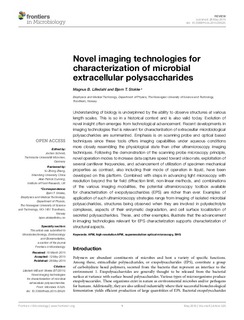Novel imaging technologies for characterization of microbial extracellular polysaccharides
Journal article, Peer reviewed
Permanent lenke
http://hdl.handle.net/11250/2359447Utgivelsesdato
2015Metadata
Vis full innførselSamlinger
- Institutt for fysikk [2701]
- Publikasjoner fra CRIStin - NTNU [38518]
Sammendrag
Understanding of biology is underpinned by the ability to observe structures at various length scales. This is so in a historical context and is also valid today. Evolution of novel insight often emerges from technological advancement. Recent developments in imaging technologies that is relevant for characterization of extraceullar microbiological polysaccharides are summarized. Emphasis is on scanning probe and optical based techniques since these tools offers imaging capabilities under aqueous conditions more closely resembling the physiological state than other ultramicroscopy imaging techniques. Following the demonstration of the scanning probe microscopy principle, novel operation modes to increase data capture speed toward video rate, exploitation of several cantilever frequencies, and advancement of utilization of specimen mechanical properties as contrast, also including their mode of operation in liquid, have been developed on this platform. Combined with steps in advancing light microscopy with resolution beyond the far field diffraction limit, non-linear methods, and combinations of the various imaging modalities, the potential ultramicroscopy toolbox available for characterization of exopolysaccharides (EPS) are richer than ever. Examples of application of such ultramicroscopy strategies range from imaging of isolated microbial polysaccharides, structures being observed when they are involved in polyelectrolyte complexes, aspects of their enzymatic degradation, and cell surface localization of secreted polysaccharides. These, and other examples, illustrate that the advancement in imaging technologies relevant for EPS characterization supports characterization of structural aspects.
